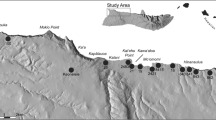Abstract
The community of Gamboa is located on Itacuruçá Island, Sepetiba Bay (State of Rio de Janeiro, Brazil) and includes 26 families, mostly of artisanal fishermen who use paddled or motor canoes, and encircling nets for fishing. In this study, predictions from optimal foraging theory (patch model), in particular of patch residence time, are compared to the observed behavior of fishermen on fishing trips. Fishermen's strategies differ depending on their intended prey. They spend more time in patches and use fewer patches for shrimp than for fish. Gamboa's fishermen tend to leave a patch later than predicted by the model. The difficulty in evaluating stock availability, the comparatively few patches available for shrimp, and the competitive aspects of fishing contribute to the explanation of this behavior.
Similar content being viewed by others
References
Acheson, J. M. (1981). Anthropology of fishing.Annual Review of Anthropology 10: 275–316.
Beckerman, S. (1983a). Carpe diem: An optimal foraging approach to Barí fishing and hunting. In Harnes, R. B., and Vickers, W. T. (eds.),Adaptive Responses of Native Amazonians. Academic Press, Nw York, pp. 269–299.
Beckerman, S. (1983b). Optimal foraging group size for a human population: The case of Barí fishing.American Zoologist 23: 283–290.
Begossi, A. (1989). Food Diversity and Choice, and Technology in a Brazilian Fishing Community (B⊓ios Island, São Paulo State). Ph.D. dissertation, University of California, Davis.
Begossi, A. (1991). Sepetiba Bay project: An ecological approach to fishing communities.Human Ecology Bulletin Spring/Summer (7): 4–7.
Begossi, A. (in press). Fishing Activities and Strategies at Búzios Island. World Fisheries Congress, May 3–8, Athens. In theProceedings of the World Fisheries Congress, Theme 2.
Begossi, A., and Braga, F. M. de S. (1992). Food taboos among fishermen from the Tocantins River.Amazoniana 12: 101–118.
Charnov, E. L. (1976). Optimal foraging theory: The marginal value theorem.Theoretical Population Biology 9: 129–136.
Clark, C. W. (1985).Bioeconomic Modelling and Fisheries Management. John Wiley & Sons, New York.
Durreberger, E. P., and Pálsson, G. (1986). Finding fish: The tactics of Icelandic skippers.American Ethnologist 13: 212–229.
Fernandez, F. A. S., Cerqueira, R., and Tribe, C. J. (1988). On the mammals collected on coastal islands of Rio de Janeiro State, Brazil.Mammalia 52: 219–224.
Gross, L. J. (1986). An overview of foraging theory. In Hallam, T. G., and Levin, S. A. (eds.),Biomathematics (Vol. 17), Mathematical Ecology. Springer-Verlag, Berlin, pp. 37–57.
Hames, R. B., and Vickers, W. T. (1982). Optimal diet breadth theory as a model to explain variability in Amazonian hunting.American Ethnologist 9: 358–379.
Hawkes, K., Kaplan, H. H., Hill, K., and Hurtado, A. M. (1987). Aché at the settlement: Contrasts between farming and foraging.Human Ecology 15: 133–162.
Hill, K., and Hawkes, K. (1983). Neotropical hunting among the Aché of Eastern Paraguay. In: Hames, R. B., and Vickers, W. T. (eds.),Adaptive Responses of Native Amazonians. Academic Press, New York, pp. 139–188.
Hill, K., Kaplan, H., Hawks, K., and Hurtado, A. M. (1985). Men's time allocation to subsistence work among the Aché of eastern Paraguay.Human Ecology 13: 29–48.
Hurtado, A. M. Hawkes, K., Hill, K., and Kaplan, H.(1985). Female subsistence strategies among Aché hunter-gatherers of eastern Paraguay.Human Ecology 13: 1–28.
Lacerda, L. D., Koudstaal, R., Bower, B. T., and Pfeiffer, W. C. (1988). Sepetiba Bay Management Study. IFIAS research program on coastal resources management, The International Federation of Institutes for Advances Study, the Netherlands.
Lendrem, D. (1986).Modelling in Behavioral Ecology. Tiber Press, Portland, OR.
Mangel, M., and Clark, C. W. (1983). Uncertainty, search and information in fisheries.J. Cons. Int. Explor. Mer. 41: 93–103.
Mangel, M., and Clark, C. W. (1988).Dynamic Modeling in Behavioral Ecology. Princeton University Press, Princeton.
McCay, B. J. (1981). Optimal foragers or political actors? Ecological analyses of a New Jersey fishery.American Ethnologist 8: 356–381.
Orians, G. H., and Pearson, N. E. (1979). On the theory of central place foraging, in Horn, D. J., Stairs, G. R., and Mitchell, R. D. (eds.),Analysis of Ecological Systems. Ohio State University, Columbus.
Pyke, G. H. (1984). Optimal foraging theory: A critical review.Annual Review of Ecology and Systematics 15: 523–575.
Real, L., and Caraco, T. (1986). Risk and foraging in stochastic environments.Annual Review of Ecology and Systematics 17: 371–390.
Stephens, D. W., and Krebs, J. P. (1986).Foraging Theory. Princeton University Press, Princeton.
Stocks, A. (1983). Cocamilla fishing: Patch modification and environmental buffering in the Amazon varzea. In Hames, R. B., and Vickers, W. (eds.),Adaptive Responses of Native Amazonians. Academic Press, New York, pp. 239–267.
Thorlindsson, T. (1988). The skipper effect in the Icelandic herring fishery.Human Organization 47: 199–212.
Winterhalder, B., and Smith, E. A. (1981).Hunter-Gatherer Foraging Strategies. University of Chicago Press, Chicago.
Author information
Authors and Affiliations
Rights and permissions
About this article
Cite this article
Begossi, A. The use of optimal foraging theory in the understanding of fishing strategies: A case from Sepetiba Bay (Rio de Janeiro State, Brazil). Hum Ecol 20, 463–475 (1992). https://doi.org/10.1007/BF00890430
Issue Date:
DOI: https://doi.org/10.1007/BF00890430




